文章目录
- 写在前面
- 链表OJ调试技巧
- 移除链表元素
- 反转链表
- 链表的中间节点
- 链表中倒数第K个节点
- 链表分割问题
写在前面
本篇为本人学习链表的过程中遇到的典型OJ题,于是整理出来分享思路和便于后续重新学习,每个标题均可跳转至对应习题,大多为Leetcode
链表OJ调试技巧
Leetcode中只能看到函数体,不能看到链表的具体情况,因此调试存在困难,自己搭建链表又过于繁琐,这里介绍一种很方便的链表调试技巧
原理如下
#include <stdio.h>
#include <stdlib.h>
#include <assert.h>struct ListNode
{int val;struct ListNode* next;
};int main()
{struct ListNode* n1 = (struct ListNode*)malloc(sizeof(struct ListNode));assert(n1);struct ListNode* n2 = (struct ListNode*)malloc(sizeof(struct ListNode));assert(n2);struct ListNode* n3 = (struct ListNode*)malloc(sizeof(struct ListNode));assert(n3);struct ListNode* n4 = (struct ListNode*)malloc(sizeof(struct ListNode));assert(n4);struct ListNode* n5 = (struct ListNode*)malloc(sizeof(struct ListNode));assert(n5);n1->val = 1;n2->val = 2;n3->val = 3;n4->val = 4;n5->val = 5;n1->next = n2;n2->next = n3;n3->next = n4;n4->next = n5;n5->next = NULL;
}
我们只需要创建出每一个节点,接着把这些节点都连在一起,手动创建一个链表,链表中需要多少个元素自己搭建,这样可以便于调试,解决OJ中遇到的问题~~
介绍完调试的方法,正式总结链表中的OJ题目
移除链表元素
给你一个链表的头节点 head 和一个整数 val ,请你删除链表中所有满足 Node.val == val 的节点,并返回 新的头节点
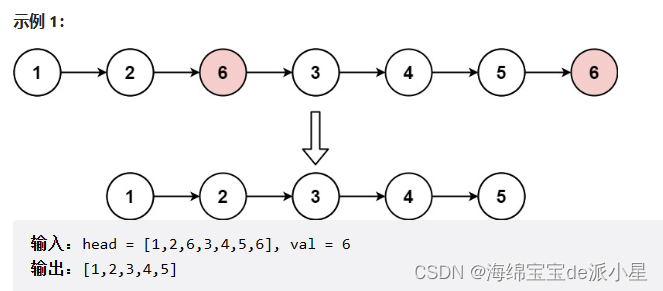
1.遍历,是val的删掉
一种暴力解决的方法,图示如下
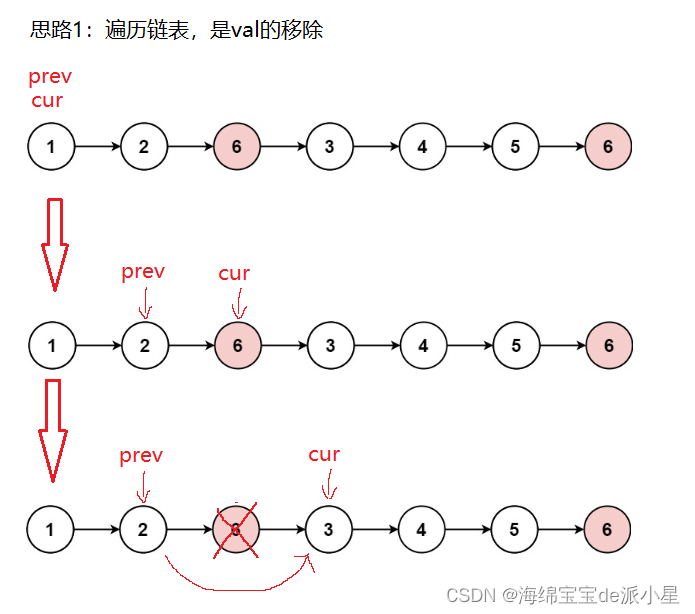
代码实现如下
/*** Definition for singly-linked list.* struct ListNode {* int val;* struct ListNode *next;* };*/struct ListNode* removeElements(struct ListNode* head, int val)
{struct ListNode* prev=NULL;struct ListNode* cur=head;while(cur){if(cur->val==val){if(prev){prev->next=cur->next;free(cur);cur=prev->next;}else{cur=head->next;free(head);head=cur;}}else{prev=cur;cur=cur->next;}}return head;
}
2.遍历链表,把不是val的拿下来尾插
图解过程如下:
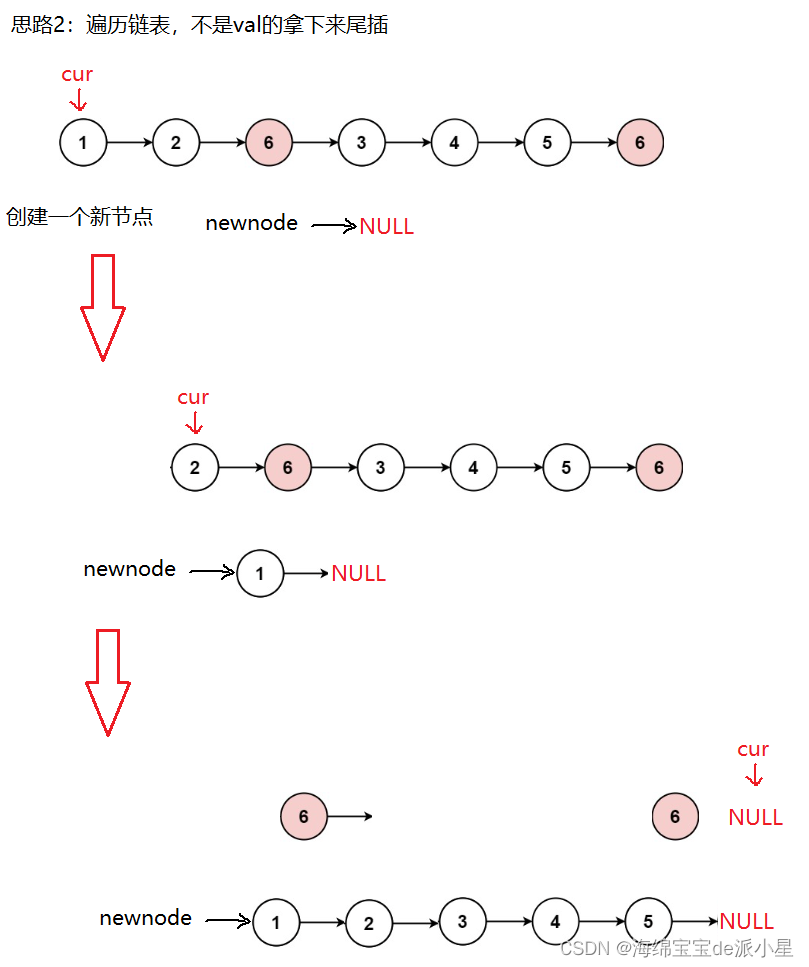
代码如下所示
struct ListNode* removeElements(struct ListNode* head, int val)
{struct ListNode* cur=head;struct ListNode* newnode = NULL;struct ListNode* tail = NULL;while(cur){if(cur->val!=val){if(tail==NULL){newnode=tail=cur;}else{tail->next=cur;tail=tail->next;}cur=cur->next;}else{struct ListNode* del=cur;cur=cur->next;free(del);}}if(tail)tail->next=NULL;return newnode;
}
反转链表
给你单链表的头节点 head ,请你反转链表,并返回反转后的链表
输入:head = [1,2,3,4,5]
输出:[5,4,3,2,1]
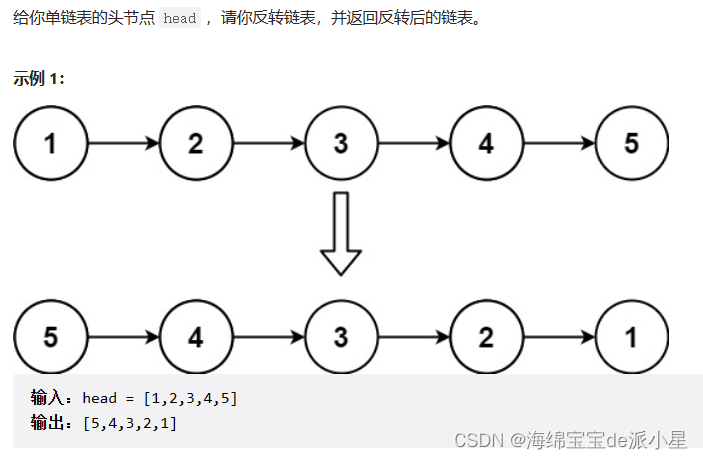
下面介绍两种思路,均能解决问题
1.改变节点指向
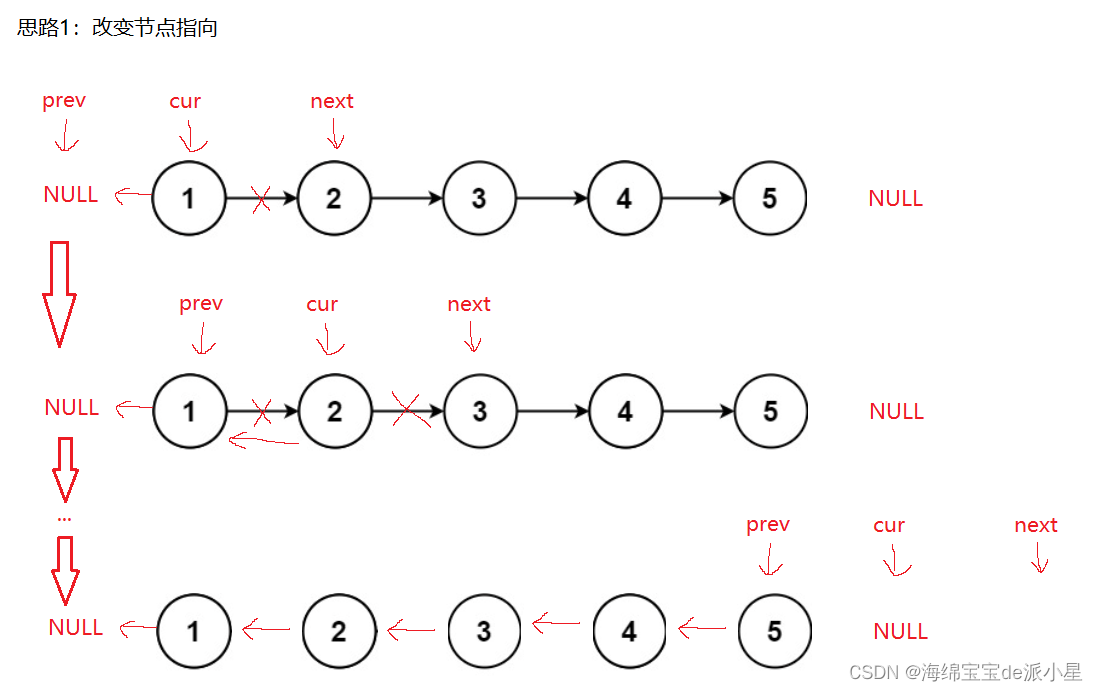
定义三个节点(思考为什么定义三个而不是两个?)而后通过指针遍历把cur指向的节点方向指向前一个,然后通过迭代到末尾,当cur为空退出循环
代码实现如下
/*** Definition for singly-linked list.* struct ListNode {* int val;* struct ListNode *next;* };*/struct ListNode* reverseList(struct ListNode* head)
{if(head==NULL)return NULL;struct ListNode* prev=NULL;struct ListNode* cur=head;struct ListNode* next=head->next;while(cur){cur->next=prev;prev=cur;cur=next;if(next)next=next->next;}return prev;
}
2.将每一个节点都头插
是一个新方法,只需要把新创建一个头,然后把每一个节点都头插进来即可,下面为原理图
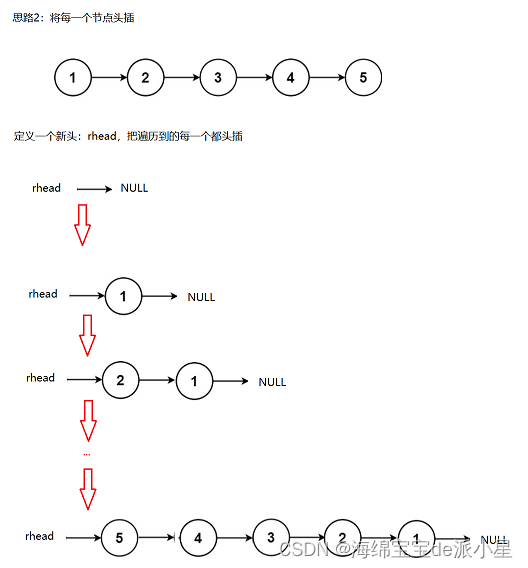
代码实现如下
struct ListNode* reverseList(struct ListNode* head)
{struct ListNode* cur = head;struct ListNode* rhead = NULL;while (cur){struct ListNode* next = cur->next;//头插cur->next = rhead;rhead = cur;//迭代cur = next;}return rhead;
}
关于代码简洁性:
代码简洁程度取决于特殊情况的处理,例如,假设这里把next定义在while循环外,那么假设参数为NULL,就需要对特殊情况做处理,此时代码就多了if条件,整体来说简洁程度就降低了
简洁程度需要对特殊情况的处理足够好,才能足够精炼解决问题
链表的中间节点
给你单链表的头结点 head ,请你找出并返回链表的中间结点。
如果有两个中间结点,则返回第二个中间结点。
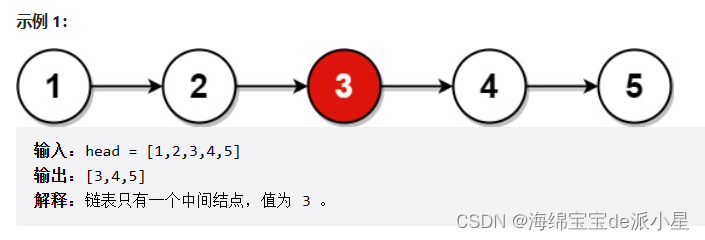
1.遍历链表求长度
代码实现如下
/*** Definition for singly-linked list.* struct ListNode {* int val;* struct ListNode *next;* };*/struct ListNode* middleNode(struct ListNode* head)
{struct ListNode* plist=head;int flag=0;while(plist){while(plist->next!=NULL){plist=plist->next;flag++;}break;}flag+=1;flag=flag/2+1;for(int i=1;i<flag;i++){head=head->next;}return head;
}
2.快慢指针法
定义两个指针,一个指针是慢指针,每次走一步;一个指针是快指针,每次走两步。当快指针走到末尾时,慢指针走的位置恰好为整个链表的一半
相比起思路1来说,时间复杂度只是O(N),从时间复杂度来讲,这个方法更优
具体实现原理如下图所示
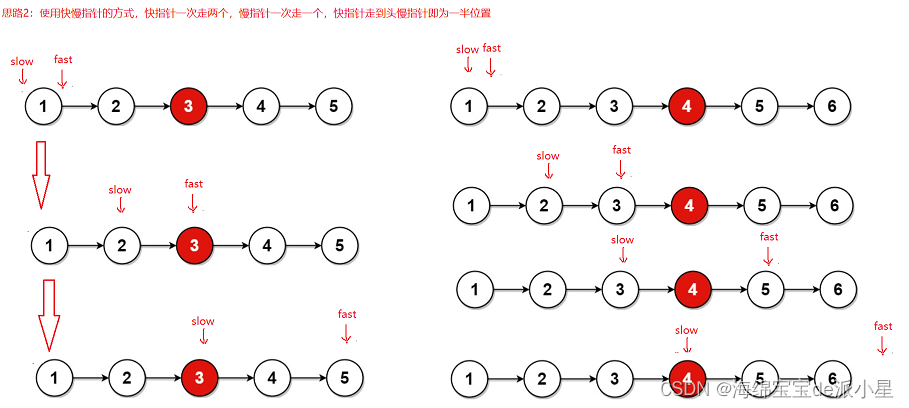
代码实现如下
struct ListNode* middleNode(struct ListNode* head)
{struct ListNode* slow=head;struct ListNode* fast=head;while(fast!=NULL && fast->next!=NULL){slow=slow->next;fast=fast->next->next;}return slow;
}
链表中倒数第K个节点
描述
输入一个链表,输出该链表中倒数第k个结点。
输入:1,{1,2,3,4,5}
输出:{5}

1.遍历求长度,根据k求结果
代码思路和上题十分类似,十分简单
/*** struct ListNode {* int val;* struct ListNode *next;* };*//*** * @param pListHead ListNode类 * @param k int整型 * @return ListNode类*/
struct ListNode* FindKthToTail(struct ListNode* pListHead, int k ) {// write code herestruct ListNode* cur=pListHead;struct ListNode* prev=pListHead;int flag=0;while(cur){cur=cur->next;flag++;}if(k>flag){return NULL;}for(int i=0;i<flag-k;i++){prev=prev->next;}return prev;
}
2.仿照上题,快慢指针的方法解决
和上题相比,略有不同的一点是,上面的快指针每次走的是一样的,而对于这个题来说,假设K=4,那么就令快指针每次走四格,其余思路和上题类似
总结原理:这里既然要求的是倒数第k个,那么就令fast指针和slow指针之间差k个,然后两个一起走,当fast指针到末尾的时候,slow所在的位置就是fast位置减去它们一开始的距离差,也就是倒数k个的位置
整体思路是十分巧妙的,其实原理和方法1类似,都是找到最后一个元素,然后再找前面倒数的元素,但相比起来使用快慢指针的方法可以让时间复杂度缩短到最少
代码实现如下
struct ListNode* FindKthToTail(struct ListNode* pListHead, int k ) {struct ListNode* fast=pListHead;struct ListNode* slow=pListHead;for(int i=0;i<k;i++){if(fast)fast=fast->next;elsereturn NULL;}while(fast){fast=fast->next;slow=slow->next;}return slow;
}
这里思考
第一次走k步和走k-1步有什么区别?
链表分割问题
题目描述
现有一链表的头指针 ListNode* pHead,给一定值x,编写一段代码将所有小于x的结点排在其余结点之前,且不能改变原来的数据顺序,返回重新排列后的链表的头指针
由于题目描述中提到,不能改变原来的数据顺序,那么也就意味着只能尾插,因为尾插不会破坏数据顺序
于是,我们要做的实际上就是把小于val的单独拿出来,大于等于val的单独拿出来,创建两个节点让拿出来的这两份数据分别进行尾插,最后再实现链表的合并,即可解决这个问题
代码的实现也相对简单,代码实现如下
/*
struct ListNode {int val;struct ListNode *next;ListNode(int x) : val(x), next(NULL) {}
};*/
class Partition {
public:ListNode* partition(ListNode* pHead, int x) {// write code herestruct ListNode* lesshead,*lesstail,*greaterhead,*greatertail;lesshead=lesstail=(struct ListNode*)malloc(sizeof(struct ListNode));greaterhead=greatertail=(struct ListNode*)malloc(sizeof(struct ListNode));struct ListNode* cur=pHead;while(cur){if(cur->val<x){lesstail->next=cur;lesstail=lesstail->next;}else {greatertail->next=cur;greatertail=greatertail->next;}cur=cur->next;}//链表合并lesstail->next=greaterhead->next;greatertail->next=NULL;pHead=lesshead->next;free(lesshead);free(greaterhead);return pHead;}
};
)




)
)


- 高级滑动(超详解))

和分区(Partition)是什么?它们之间有什么关系?)


 | EI Compendex, Scopus双检索)




